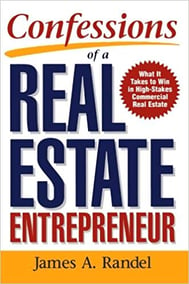 James A. Randel, the author of Confessions of a Real Estate Entrepreneur, has been a lawyer by trade and a successful real estate investor since 1980.
James A. Randel, the author of Confessions of a Real Estate Entrepreneur, has been a lawyer by trade and a successful real estate investor since 1980.
Randel is a master at distilling technical, complex subjects into easy-to-understand examples. Stories and anecdotes are used throughout the book to highlight his real-world real estate investing successes and failures.
Key Takeaways/Lessons Learned
- Real estate investing is risky but can lead to greater profits when risk is minimized
- Adding value to real estate can be accomplished in a variety of different ways
- Wise use of debt can increase returns
- Options and contract contingencies can be key tools for adding value prior to closing
- Real estate investors can generate income even when an owner refuses to sell
Summaries from Confessions of a Real Estate Entrepreneur
In the introduction to Confessions of a Real Estate Entrepreneur, James A. Randel correctly notes:
“Real estate investing is not some magic potion to riches. Yes, it’s a means for making a lot of money. But it’s no risk-free, lazy man’s way to wealth. It’s hard work. And there is definitely risk involved. But with information, diligence, determination, and calculated risk, there is plenty of opportunity to make A LOT of money.”
The general premise of the book is that real estate investing is most successful when value is added, through the process of acquiring the property and/or the property itself. Throughout the book, Randel uses real-life stories based on his personal experiences to drive home his investing confessions.
With that in mind, let’s take a look at the summaries from the rest of Confessions of a Real Estate Entrepreneur.

Possibilities
Would you be interested in buying a $5.5 million property by investing only $100,000 in closing costs, then selling it two years later for a $3 million profit? That’s exactly what two of the author’s friends did, enjoying a 1,500% return on their investment.
They created millions of dollars in value by thinking outside of the box. Because the property was occupied by a single tenant whose long-term prospects appeared shaky, the investors were able to acquire the property by assuming the existing mortgages.
Then, by exercising a sub-tenant clause in the lease, they replaced the original tenant with a AAA credit tenant on a longer lease at a higher annualized rent. By adding value to the property with a credit-quality tenant, the investors were able to turn a seven-figure profit in only a couple of years.
The Basics
Randel reviews the basic terms of real estate investing, and how they are actually used in real life. Ownership structures, types of deeds, mortgages and subordination clauses, contract law and consideration, the Statute of Frauds, clauses and contingencies, leases and rents are all explained in detail.
In this chapter, Confessions of a Real Estate Entrepreneur discusses how to increase value by offering tenants free rent. In exchange for a rent concession, the tenant agrees to pay an above market rent over the lease term. The higher NOI makes the property worth more even though the owner has paid nothing out of pocket.
Options
An option is an agreement for the Seller to sell, but not necessarily an obligation of the Buyer to buy. If the option isn’t exercised by the Buyer, the Option Payment may be lost, but no other monetary damages will be incurred – provided the Option Agreement is structured properly.
Because an Option Payment is usually less than an earnest money deposit, options are an easy way for a Buyer to tie up property while adding value before the sale takes place. When the deal closes, the property is already worth more than the purchase price.
For example, in some markets, investors are buying larger, older single-family homes and adding value by converting them into multifamily properties. Controlling the property with an option lets the buyer make sure zoning will be approved before committing to a purchase agreement.
Contracts with Contingencies
A contingency is an event that must happen before a party to the contract becomes obligated. Buyers are normally the party with contingencies that can work in their favor, such as a contract being contingent on obtaining financing. If a mortgage can’t be secured, the Buyer can receive all earnest money back and walk away from the deal.
As Randel illustrates in this chapter, contingencies can also be used to add value. That’s because contingencies can be used the same way the options are used.
Many times, Sellers prefer to have their property under contract rather than under an option. Using our single-family to multifamily conversion from above as an example, a Buyer could include a zoning contingency in the purchase agreement to satisfy the objectives of the Seller and the Buyer.
Development
Finding and buying land to develop into an industrial park or multifamily property to sell or lease can be extremely profitable, but also very risky. However, Confessions of a Real Estate Entrepreneur illustrates several ways to minimize risk to projects under development.
Randel uses the example of a build-to-suit property leased to a credit quality tenant on a long-term triple net lease (NNN). In addition to the tenant paying all of the building operating expenses, the tenant has also agreed to annual rent increases for the next 20 years.
Lease in hand, the developer goes to the lender and obtains a loan based on the future rental cash flow from the tenant. Of course, this approach means the developer has to accurately predict current and future rent rates, cap rates, and property values several years down the road.
Revitalizing Existing Properties
Randel also describes how pre-leasing can add value to an existing property being revitalized.
For example, let’s assume the total cost to convert our single-family home into a 3-unit multifamily property is $500,000 – including the cost of acquiring the property and construction.
In a market where cap rates run 5% and the single-family rent was $24,000 per year, the property value would be $480,000 ($24,000 / 5% = $480,000). By pre-leasing each of the three multifamily units for $12,000 per year, the developer has increased the property value to $720,000 ($36,000 / 5% = $720,000).
At a conservative 75% LTV, the developer can now go to a lender and obtain financing for $540,000, more than enough money to acquire and convert the building.
A Complete Makeover
This type of deal is done by purchasing a property that the market perceives one way, then through a combination of renovation, marketing, and repositioning transform the property into something else.
Randel uses examples of how older, obsolete industrial property is transformed into self-storage, and how large but outdated factory buildings in up-and-coming locations can be made over into factory outlet stores.
Although these examples may be outdated, the principle used to add value is still very valid today:
“If you can purchase property that is priced on one model and effect a dramatic change in the use and perception of the property, you may make a lot of money.”
Other Mistakes I’ve Made
This is hands-down one of the best chapters in Confessions of a Real Estate Entrepreneur. That’s because successful investors know that the best way to jump-start their real estate investment business is by learning from the mistakes of others.
Randel describes how trying to reposition a property from industrial to retail backfired on him because a zoning contingency wasn’t used. Then, he explains how a potentially profitable residential land development deal turned into a $1.5 million loss because he was overly optimistic and under-experienced.
As the author notes, real estate entrepreneurs can and will make mistakes. But if you’re afraid of striking out, you’ll never get to the batter’s box. Maximize your potential for success and minimize your potential for failure by:
- Never taking anything for granted
- Always be hustling
- Stick with what you know or partner with somebody who knows what you don’t
- Take the lead or get out of the deal, but don’t be passive
- When a deal works for you, don’t try pushing a base hit into a double play
Buying Wholesale, Selling Retail
Buying at wholesale and selling at retail is Randel’s variation of buy low, sell high.
He writes about the “condo conversion phenomenon” that took place in the 1980s. Real estate investors were making enormous amounts of money by purchasing apartment buildings and turning them into individual condominium units that were then re-sold to homeowners.
Today of course, there’s more demand for rental property. Randel acknowledges that markets change, noting “I’m not sure what will be the next opportunity to buy wholesale and sell retail. I JUST WANT TO BE THERE FIRST.”
The Next New Great Idea
The goal of real estate investors is to keep up with what’s hot and what’s not and - if they’re smart - to create new ideas to add value on their own. The book uses “condo hotels” as an example.
Investors purchase a condo unit that is used most of the time as a hotel room that is rented out daily. Value is added by offering increased hotel-like services to the tenant, while the owner receives additional value with a higher daily hotel rental rate. Theoretically, the extra revenues cover all or some of the cost of owning the condo-hotel unit.
Randel closes this chapter of Confessions of a Real Estate Entrepreneur by observing,
“The great thing about being an entrepreneur is that there is no one right path. Any way that drops money to the bottom line is, in my view, a ‘right way.’ So, don’t be stuck in thinking that you need to do something as others are doing it or in the way it has always been done.”
Buying Ahead of the Crowd
Fortunes are made in real estate by buying properties in front of the crowd. Areas evolve into not-so-desirable to highly desirable, and vice versa.
Signs that property values in a given area may begin rising include:
- Universities buying up property for renovation
- Run-down buildings being razed
- Newer and better stores and restaurants opening
- Crime areas being better policed
- Young adults with families moving into the neighborhood
Of course, spotting developing trends can be easier said than done. Sometimes, it’s difficult to miss the forest by only looking at the trees. It’s human nature to at times miss what’s happening in your own backyard.
Real estate entrepreneurs who buy ahead of the crowd have mastered the game of buying five years or more ahead of demand. Then, they buy and hold, waiting for prices to rise and profits to be earned.
Brokerage
Randel began his career as a real estate attorney and got his real estate license shortly after beginning his own legal practice. In hindsight, he learned there’s no better point of entry into the real estate game than real estate brokerage.
That’s because you’re exposed every day to buyers and sellers, landlords and tenants, property managers and lenders. For a real estate investor, owning or working in a real estate brokerage is like having a ready-made information pipeline for picking and choosing potential deals that others may not see value in.

Leases and Other Property Interests
Confessions of a Real Estate Entrepreneur also teaches us how to make money in real estate without owning real property. Sometimes, for various reasons, owners simply don’t want to sell but they’re very willing to lease what they own.
For example, real estate investors can use a long-term ground lease to develop property and create value without actually owning the land.
By signing a 99-year lease with the owner, an investor can arbitrage the difference between the ground lease rate paid to the owner and the market value rental rate a tenant pays to occupy the investor’s newly developed building.
Good real estate investors don’t take no for an answer. As Randel says, they just find another way to skin the cat.
Other People’s Money
This chapter of Confessions of a Real Estate Entrepreneur distills the whole idea of leverage into a few short sentences:
“If you can get someone else’s money to help you consummate a deal: (a) Without putting the fundamentals of the deal at undue risk; and (b) While keeping a disproportionate share of the upside, then take as much as you can.”
Randel also explains how and why lenders love to loan on property with added value.
Lenders want to make loans because they earn a spread between the rate they pay and the rate they lend at. There is no absolute value to real estate provided value can be added, and lenders are not looking for a piece of the action by participating with investors on the upside.
Finding Deals
WHATEVER WORKS is the only rule that really matters when it comes to finding deals. Confessions of a Real Estate Entrepreneur lists several proven methods for finding deals including:
- Real estate brokers are willing to work with investors who can and will move quickly and aggressively to tie up and close on a property
- Networking in your local market with professionals such as accountants, attorneys, bankers, City Hall employees, financial planners, and stockbrokers
- General media and trade journals to learn about economic events in your market area
- Cold calling and driving an area because a lot of investors don’t or won’t make this extra effort
When You’re a Seller
So far, the book has discussed how real estate investors can buy and control property. In this chapter, Randel changes gears and discusses what real estate entrepreneurs need to know about when and how to sell.
While the right time to sell varies from investor to investor, Confessions of a Real Estate Entrepreneur suggests:
“When you have added value to a property to the point where your incremental gains in value will generate returns on your capital in the deal that are ‘institutional’ (i.e., returns that would be satisfactory to big institutions like pension funds, about 5 to 8 percent per year) rather than entrepreneurial, it’s time to start thinking about selling.”
Regarding how to sell, Randel believes there are two critical skills in selling a commercial property:
- Knowing how to position the property to be attractive to the purchaser
- Knowing how to negotiate the price and terms of the sale

Attorneys
James A. Randel had practiced law for 25 years before writing Confessions of a Real Estate Entrepreneur. So, it’s definitely worth reading what he has to say about real estate attorneys:
- Do not rely on your attorney to finalize a deal
- Do not rely on your attorney to address potential business issues in important documents
- Never be afraid to ask stupid questions
- Do not negotiate fees or delay payment
- Understand how your attorney views risk – yours and his
Randel ends this chapter by advising, “It is only natural for each of us to want to believe that someone is watching out for our best interests . . . but if you put this responsibility entirely in the hands of your attorney, you could be very disappointed.”
The Art of Persuasion
Success in the real estate world is more a function of people skills than factors such as superior intelligence, higher education, or even capital. Successful real estate investors don’t need to be masters of high tech and don’t even need college degrees.
What they do need to know is how to understand and connect with people. Fortunately, these are skills that can be learned and honed by almost anyone with the desire to succeed in investment real estate.
Randel lists 10 lessons in the Art of Persuasion:
- Prepare for the persuasion opportunity
- The more they like you, the greater the probability of success
- Keep control of the discussion
- Know your subject matter
- Listen, listen, listen
- Stay focused
- Establish your limits in advance
- Become the other party
- Wait two beats before speaking
- Don’t try too hard and push the other party
The key takeaway for the chapter is this:
“The probability of success in persuading someone to decide in your favor can be greatly increased if you think through the art and process of persuasion.”
Success Skills
Success in real estate investing isn’t an accident. Instead, successful people apply themselves in a way that maximizes the probability of positive outcomes.
Successful people in all walks of life do many of the same things to achieve success:
- Success Skill 1: Passion
- Success Skill 2: Work Ethic
- Success Skill 3: Physicality
- Success Skill 4: No Sense of Entitlement
- Success Skill 5: Discipline
- Success Skill 6: Networking
- Success Skill 7: Visualization
- Success Skill 8: Grit and Perseverance
- Success Skill 9: Running Scared
- Success Skill 10: Self-Improvement
- Success Skill 11: Grace and Balance
- Success Skill 12: Karma
- Success Skill 13: Integrity
Randel notes that while there are no guarantees in life, following these skills for success will greatly increase the probability of achieving the result you’re looking for.
Is Confessions of a Real Estate Entrepreneur Worth Reading?
The book uses real world examples of how to add value to investment real estate while balancing risk. Value can be added to real estate in a variety of different ways including rezoning and refinancing, while risk can be minimized through hard work and due diligence.
With those themes in mind, the book is probably best for active investors focused on growing their real estate portfolio.
Strengths
- Complex subjects are explained in an easy-to-understand manner
- A storytelling approach with real world examples is used throughout the book
- The author explains in detail mistakes he and his partners have made, so that lessons can be learned from their mistakes
Weaknesses
- Book focuses on commercial real estate such as office, retail, and land development
- At times, the storytelling approach can be too lengthy
- Investors who aren’t concerned with adding value and growing their property portfolios may find limited use for the book
Conclusion
Many real estate investors overlook the importance of adding value to make more money from investment real estate. Confessions of a Real Estate Entrepreneur describes in detail how seemingly minor items like a contract contingency or pre-leasing can magnify investment returns.
Although the book uses examples from commercial real estate deals, it’s easy to see how the examples discussed in this book can apply to single-family and smaller multifamily investments as well.
If you're ready to put these financial principles into practice, check out Roofstock's resources to help you get started. We have the investment opportunities, strategies, and analysis you need to move forward toward your goals.











